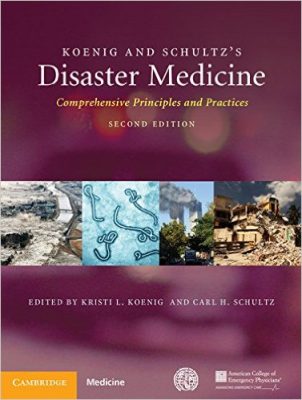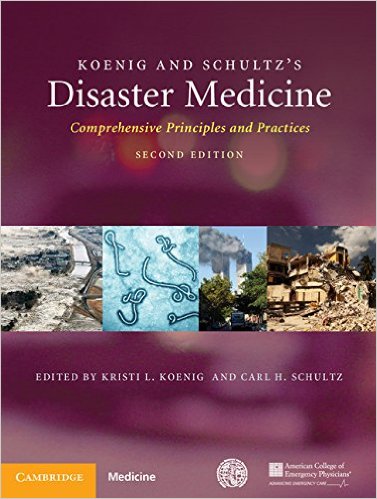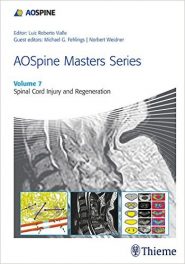 Editors: Kristi L. Koenig, MD; and Carl H. Schultz, MD
Editors: Kristi L. Koenig, MD; and Carl H. Schultz, MD
Publisher: Cambridge University Press – 764 pages
Book Review by: Nano Khilnani
The importance of this book cannot be overemphasized. While the focus of this book is on how to save lives from natural disasters, the world has recently witnessed numerous manmade intentional disasters in the form of terrorist attacks in which thousands of people have been killed. The knowledge we have gained on how to save the lives of victims of natural disasters is also applicable to saving lives after accidents and terrorist attacks.
This does not mean that natural disasters have become less frequent in occurrence since the first edition was published in 2009. We reviewed the first edition of this book on January 13 (here’s the link to that review: http://www.bizindia.net/?s=disaster+medicine) and because this subject relates to nothing less than saving as many lives as possible, we are also reviewing this larger second edition, containing nearly 100 more pages and four more chapters, with updated and additional information.
Seventy-four people, who are physicians, and specialists in areas relating to disaster relief and response, from the United States, and ten other countries – Austria, Belgium, Canada, Ireland, Israel, Scotland, Singapore, Sweden, Taiwan, and the United Kingdom – authored the 43 chapters of this second edition of this large, highly important book.
Like the first edition with 39 chapters, the 43 chapters this second edition are organized into three basic Parts:
- Part I. Conceptual Framework and Strategic Overview
- Part II. Operational Issues
- Part III. Clinical Management
The coverage of subjects in this book is extensive. In the conceptual framework area, the coverage ranges from: climate change and community resilience to disaster behavior health to disaster health education and disaster research and epidemiology. There are chapters on emerging infectious diseases, ethical issues, surge capacity and scarce resource availability, and vulnerable populations.
Operational issues constitute the largest section of this book (Part II) with chapters on matters such as: crisis and emergency risk communication, complex public health emergencies, decontamination, emergency medical services scene management, explosive events, healthcare facility disaster management, mass facility management, personal protective equipment, quarantine, transportation disasters, and triage.
In the realm of clinical management, the chapters cover catastrophes such as: biological events, burn disasters, chemical events, cyclones, earthquakes, floods, hazardous materials, landslides, radiation accidents, tornadoes, tsunamis, volcanoes, and winter storms.
In this second edition, two chapters have been added to Part I of this book. They are Climate Change and Community Resilience; and two chapters have been added to Part II, which are Rehabilitation of Disaster Casualties and Explosive Events.
In chapter 4 of this edition entitled Climate Change, authors Richard A. Matthew and Jamie L. Agius write that the scientific basis of climate change on earth has “strengthened considerably” since 1896 when Swedish chemist and physicist Svante Arrhenius first stated in a hypothesis that emissions of carbon dioxide could accumulate in the atmosphere to create a greenhouse gas effect that leads to global warming.
Matthew and Agius point out: in the last 20 years or so, the Intergovernmental Panel on Climate Change (IPCC) – a global network of scientists established by the United Nations – has released four assessment reports and a dozen-plus publications and methodology papers that conclude that human activities, particularly those that involve carbon emissions and reduction of carbon storage, are “almost certainly forcing climate change.”
In chapter 6 entitled Community Resilience, authors Rose L. Pfefferbaum, Richard Reed, and Betty Pfefferbaum explore this relatively new concept. They write that community resilience, sometimes a strategy and sometimes a vision, both requires and supports disaster management which includes disaster medical response and relief.
This chapter describes the principles for building community resilience, shows how to improve its application in disaster medicine, details the currently available resources and programs, and offers recommendations for future research.
In chapter 24 entitled Rehabilitation of Disaster Casualties, authors James E. Gosney Jr. and Colleen O’Connell describe the activities in providing disaster medical relief to people severely injured in large-scale, sudden disasters. Victims in such catastrophic events may get bashed with heavy objects that result in death or consequences such as: amputation of limbs, bone fractures, peripheral nerve injury that may result in disability, spinal cord injury (SCI), or traumatic brain injury (TBI).
This chapter focuses on treatment options primarily for victims that sustain injuries that require long-term rehabilitation, such as those who may have one or several arms and or legs amputated, or those whose spinal cord has been damaged.
In chapter 29 entitled Explosive Events, authors Glenn D, Burns and John M. Wightman describe the medical response and relief given to victims of accidental or intentional blasts, bombings, and detonations. This type of occurrence is termed as a ‘potential injury / illness-creating event’ (PICE) in the specialty of disaster medicine.
A personal injury resulting from a PICE could be as minor as a skin abrasion to a ‘total body disruption’ wherein multiple body parts are severed and scattered all over a given area. Short- and long-term effects on survivors and their families can be devastating, as well as debilitating in a prolonged recovery period.
Editors:
Kristi L. Koenig, MD, FACEP, FIFEM is Professor of Medicine and Public Health, and Director of Public Health Perspectives at the University of California, Irvine. She is an internationally recognized expert in the field of homeland security, disaster and emergency medicine, emergency management, and emergency medical services.
She holds multiple appointments including Visiting Professor at universities in Australia, Belgium, and Italy. With a strong health policy and academic background, including more than 100 peer-reviewed publications and nearly 500 invited lectures in about 35 countries, she is widely sought after for presentations at regional, national, and international forums.
Carl H. Schultz, MD, FACEP is a Professor of Emergency Medicine and the Director of Research at the Center for Disaster Medical Sciences at the University of California, Irvine School of Medicine. He is an internationally-recognized expert and researcher in the fields of disaster and emergency medicine.
He chaired the Disaster Preparedness and Response Committee of the American College of Emergency Physicians and has served as a consultant for the United States Department of Defense, the Joint Commission, and the State of Israel. Dr. Schultz holds faculty positions at universities in Belgium and Italy.
Foreword:
Marvin L. Birnbaum, MD, PhD is Emeritus Professor of Medicine and Physiology at the University of Wisconsin; Past President of the World Association for Disaster and Emergency Medicine; Editor-in-Chief Emeritus of Pre-hospital and Disaster Medicine; and Co-Editor of Health Disaster Management: Guidelines for Evaluation and Research.






